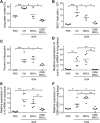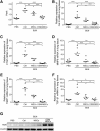Oncostatin M-Preconditioned Mesenchymal Stem Cells Alleviate Bleomycin-Induced Pulmonary Fibrosis Through Paracrine Effects of the Hepatocyte Growth Factor
- PMID: 28297588
- PMCID: PMC5442768
- DOI: 10.5966/sctm.2016-0054
Oncostatin M-Preconditioned Mesenchymal Stem Cells Alleviate Bleomycin-Induced Pulmonary Fibrosis Through Paracrine Effects of the Hepatocyte Growth Factor
Abstract
Mesenchymal stem cells (MSCs) are widely considered for treatment of pulmonary fibrosis based on the anti-inflammatory, antifibrotic, antiapoptotic, and regenerative properties of the cells. Recently, elevated levels of oncostatin M (OSM) have been reported in the bronchoalveolar lavage fluid of a pulmonary fibrosis animal model and in patients. In this work, we aimed to prolong engrafted MSC survival and to enhance the effectiveness of pulmonary fibrosis transplantation therapy by using OSM-preconditioned MSCs. OSM-preconditioned MSCs were shown to overexpress type 2 OSM receptor (gp130/OSMRβ) and exhibited high susceptibility to OSM, resulting in upregulation of the paracrine factor, hepatocyte growth factor (HGF). Moreover, OSM-preconditioned MSCs enhanced cell proliferation and migration, attenuated transforming growth factor-β1- or OSM-induced extracellular matrix production in MRC-5 fibroblasts through paracrine effects. In bleomycin-induced lung fibrotic mice, transplantation of OSM-preconditioned MSCs significantly improved pulmonary respiratory functions and downregulated expression of inflammatory factors and fibrotic factors in the lung tissues. Histopathologic examination indicated remarkable amelioration of the lung fibrosis. LacZ-tagged MSCs were detected in the lung tissues of the OSM-preconditioned MSC-treated mice 18 days after post-transplantation. Taken together, our data further demonstrated that HGF upregulation played an important role in mediating the therapeutic effects of transplanted OSM-preconditioned MSCs in alleviating lung fibrosis in the mice. Stem Cells Translational Medicine 2017;6:1006-1017.
Keywords: Bleomycin-induced pulmonary fibrosis; Hepatocyte growth factor; Oncostatin M; Preconditioning; Stem cells.
© 2016 The Authors Stem Cells Translational Medicine published by Wiley Periodicals, Inc. on behalf of AlphaMed Press.
Figures






Similar articles
-
Hypoxia-preconditioned mesenchymal stem cells attenuate bleomycin-induced pulmonary fibrosis.Stem Cell Res Ther. 2015 May 20;6(1):97. doi: 10.1186/s13287-015-0081-6. Stem Cell Res Ther. 2015. PMID: 25986930 Free PMC article.
-
Hepatocyte Growth Factor Is Required for Mesenchymal Stromal Cell Protection Against Bleomycin-Induced Pulmonary Fibrosis.Stem Cells Transl Med. 2016 Oct;5(10):1307-1318. doi: 10.5966/sctm.2015-0337. Epub 2016 Jul 7. Stem Cells Transl Med. 2016. PMID: 27388243 Free PMC article.
-
Human bone marrow-derived mesenchymal stromal cells cultured in serum-free media demonstrate enhanced antifibrotic abilities via prolonged survival and robust regulatory T cell induction in murine bleomycin-induced pulmonary fibrosis.Stem Cell Res Ther. 2021 Sep 16;12(1):506. doi: 10.1186/s13287-021-02574-5. Stem Cell Res Ther. 2021. PMID: 34530920 Free PMC article.
-
Use of human amniotic epithelial cells in mouse models of bleomycin-induced lung fibrosis: A systematic review and meta-analysis.PLoS One. 2018 May 17;13(5):e0197658. doi: 10.1371/journal.pone.0197658. eCollection 2018. PLoS One. 2018. PMID: 29772024 Free PMC article.
-
Recent advances in the therapeutic efficacy of hepatocyte growth factor gene-modified mesenchymal stem cells in multiple disease settings.J Cell Mol Med. 2022 Sep;26(18):4745-4755. doi: 10.1111/jcmm.17497. Epub 2022 Aug 3. J Cell Mol Med. 2022. PMID: 35922965 Free PMC article. Review.
Cited by
-
Human amniotic fluid mesenchymal stem cells attenuate pancreatic cancer cell proliferation and tumor growth in an orthotopic xenograft mouse model.Stem Cell Res Ther. 2022 Jun 3;13(1):235. doi: 10.1186/s13287-022-02910-3. Stem Cell Res Ther. 2022. PMID: 35659367 Free PMC article.
-
Mesenchymal stem cell as a novel approach to systemic sclerosis; current status and future perspectives.Cell Regen. 2020 Dec 1;9(1):20. doi: 10.1186/s13619-020-00058-0. Cell Regen. 2020. PMID: 33258056 Free PMC article. Review.
-
The Plastic Interplay between Lung Regeneration Phenomena and Fibrotic Evolution: Current Challenges and Novel Therapeutic Perspectives.Int J Mol Sci. 2023 Dec 31;25(1):547. doi: 10.3390/ijms25010547. Int J Mol Sci. 2023. PMID: 38203718 Free PMC article. Review.
-
Preconditioning influences mesenchymal stem cell properties in vitro and in vivo.J Cell Mol Med. 2018 Mar;22(3):1428-1442. doi: 10.1111/jcmm.13492. Epub 2018 Feb 1. J Cell Mol Med. 2018. PMID: 29392844 Free PMC article. Review.
-
Therapeutic Applications of Mesenchymal Stem Cells in Idiopathic Pulmonary Fibrosis.Front Cell Dev Biol. 2021 Mar 9;9:639657. doi: 10.3389/fcell.2021.639657. eCollection 2021. Front Cell Dev Biol. 2021. PMID: 33768094 Free PMC article. Review.
References
-
- Spagnolo P. Novel treatments for idiopathic pulmonary fibrosis. Am J Med 2015;128:447–449. - PubMed
-
- Antunes MA, Laffey JG, Pelosi P et al. Mesenchymal stem cell trials for pulmonary diseases. J Cell Biochem 2014;115:1023–1032. - PubMed
-
- Glassberg MK, Toonkel RL. Moving stem cell therapy to patients with idiopathic pulmonary fibrosis. Respirology 2014;19:950–951. - PubMed
Publication types
MeSH terms
Substances
LinkOut - more resources
Full Text Sources
Other Literature Sources
Medical

